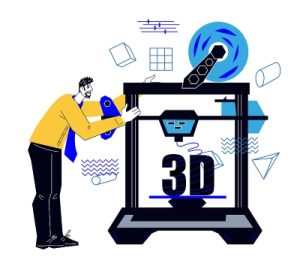
While most people are familiar with 3D printing as something your engineer neighbor messes around with in their basement to produce small models, the applications of the technology can be much more significant than a hobbyist's weekend activity. The technology is being used in some mission critical and massive scale projects across government.
Construction
An early, small-scale application of 3D printing in the construction industry was recreating historical fixtures for renovations. Historical buildings, many of which house government agencies and government-run museums, have light fixtures, molding, door knobs, etc. that may need replacing. Finding actual replacements for centuries old materials is incredibly difficult and building them from traditional materials is time consuming and costly. 3D printing has proven to be a valuable solution to maintaining the historical look quickly and at a much reduced cost.
Beyond patching and design updates, 3D printing is now being used to construct entire buildings. The University of Maine built a 600 square foot 3D printed home utilizing wood fibers. Similarly, a team in Virginia constructed a concrete-based home using 3D printing technology. Construction with 3D printing can take as little as a couple of days. Community leaders are looking at it as a way to address the shortage of affordable housing nationwide-a 3.8 million unit shortfall. Additionally, the use of environmentally friendly materials, like the wood fiber used in Maine, can improve the sustainability of communities.
Maintenance
Even when supply chains are working well, sometimes things break and you urgently need a part that is not readily available. The DoD is utilizing 3D printing to fill these kinds of gaps. Air Force officials in Virginia were able to 3D print a piece that was critical for needed refueling equipment. A replacement was created using a 3D printer in just a few minutes at a cost of just 25 cents. This kind of cost and time savings are getting noticed with a White House-backed consortium pushing smaller aerospace and defense suppliers to manufacture more 3D printed parts and use them in weapons to further ease the replacement and maintenance.
Availability of parts is especially scarce when ships are at sea, therefore, the Navy is working to deploy the first 3D printer onboard a warship. This particulate machine is unique as it is able to print using durable, raw materials including metal. Similarly, Army Materiel Command is looking at 3D printing as a way to get needed parts and technologies to mobilized soldiers.
GovEvents and GovWhitePapers feature a number of resources that address new dimensions for 3D printing.
- 2nd Annual Assured Logistics Summit (April 12-13, 2023; Oxen Hill, MD) - This event will explore efforts to supply persistent logistics in unpredictable operational environments. It will address the challenges of transporting materials, equipment, and people in an era of Strategic Competition to ensure the sustainability and survivability of the defense supply chain.
- Gartner Supply Chain Symposium/Xpo (May 8-10, 2023; Lake Buena Vista, FL) - This event will explore big ideas and deliver actionable insights to help supply chain leaders develop agile and resilient supply chain strategies, mitigate risk and respond to disruption, pursue digital initiatives, and prioritize technology investments to achieve objectives.
- Additive Manufacturing for U.S. Aerospace, Defense and Space (June 13-14, 2023; Orlando, FL) - Additive Manufacturing, or 3D printing, is quickly becoming a staple component of advanced manufacturing capability across the aerospace, space and defense industrial base. This senior and expert-led Summit will highlight the ongoing efforts to empower knowledge sharing and collaboration with those across the US military, government agencies, prime contractors and leading space companies.
- Middle-Tier Defense Acquisitions: Rapid Prototyping and Fielding Requires Changes to Oversight and Development Approaches (white paper) - The Department of Defense (DOD) is continually challenged to deliver capabilities to its warfighters at the pace of innovation. This report assesses the extent to which DOD effectively implemented policies, guidance, and processes to provide DOD with reliable data.
- Game Changer: In-Space Servicing, Assembly, and Manufacturing for the New Space Economy (white paper) - Technological progress in spacecraft life extension, debris removal, space operations autonomy, and robotics will disrupt the traditional paradigm of spacecraft design, acquisition, launch, operations, and maintenance. A new generation of spacecraft designed specifically for In-space Servicing, Assembly, and Manufacturing (ISAM) is leading this charge towards a new space economy.
For more on the future of 3D printing in government visit GovEvents and GovWhitePapers.




